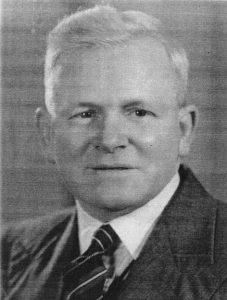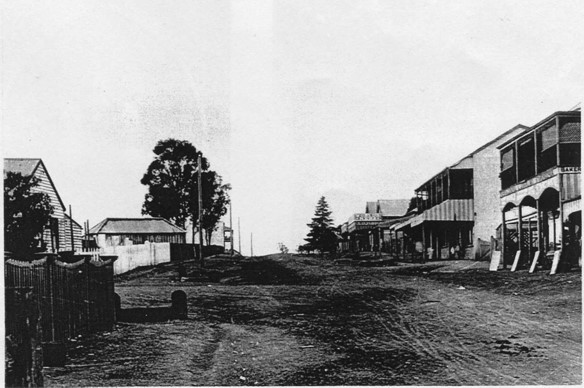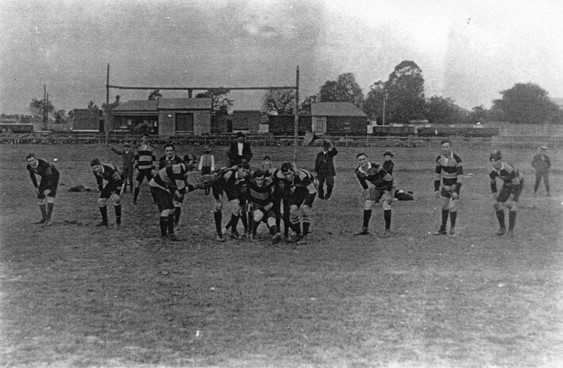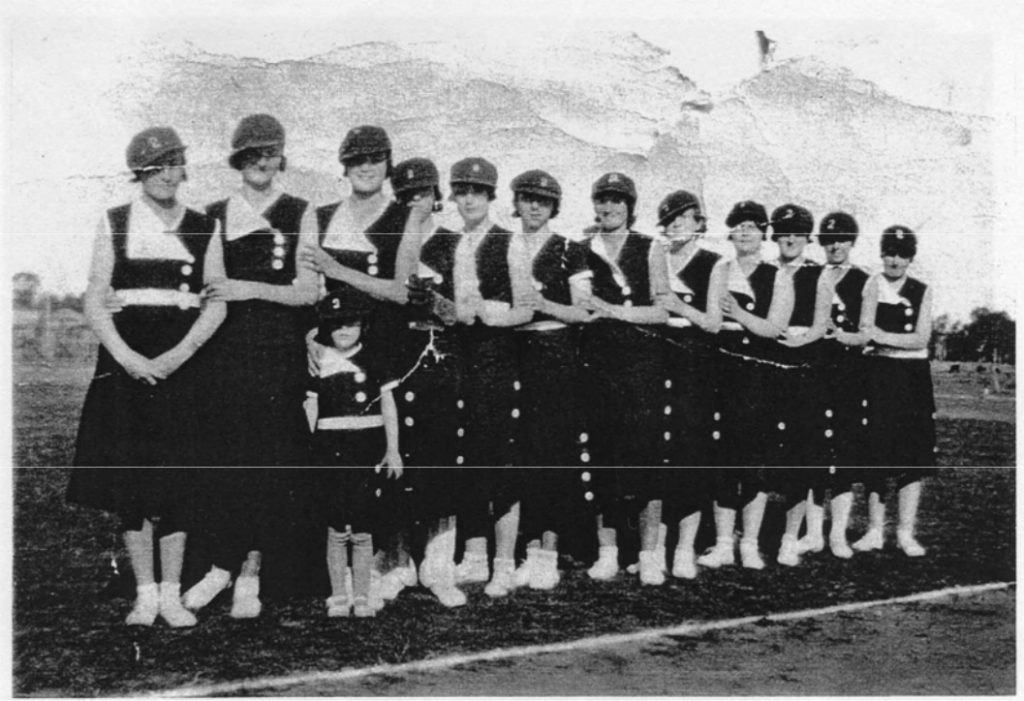In the 1980s Sam wrote letters to both the Riverstone Press and the Guardian. The following are extracts from some of Sam ‘s letters which were entitled ‘Looking Back”
Sport
Sport has always played a big part in the lives of the Riverstone people and in the early days Cricket, Football, Boxing, Horse, Dog and Foot Racing were some of the most popular pastimes.
Some of the “well knowns” whose prowess come to mind are Herb Freeman, cricketer; Claude Schofield and “Sandy” Wiggins, two of our great early footballers; and Billy Teale, Heavyweight Boxing Champion of the Army in the 1914/18 Campaign, who fought a bout with the World Heavyweight Champion.
The Jarretts would have been among the pioneers of dog racing and many a good dog was trained on sheep’ heads boiled up in the old kerosene tin over an open backyard fire. This same fire incidentally took care of the Monday morning wash -a far cry from our modern fully automatic washing machines
… Riverstone Press 20 September 1980
Early Parish Maps Of Riverstone
On viewing Parish Maps of the early 1800s I am quite convinced that the original O’Connell Grant of 2,500 acres was enclosed as follows:- Eastern Creek to the West; Bandon Road to the North, Windsor Road to the East and Brighton Street to the South. Grantham Farm Estate came much later and was a subdivision of portion of the original O’Connell Grant.
This old Parish Map also shows Bandon Road linking up to the old Hawkesbury Road in the east, and the West end meeting Eastern Creek near the site of Steve Upton’s Bridge. Before the Railway came to Riverstone, the Rumery Brothers carried on business as Long Distance Road Hauliers, with horse drawn vehicles of course; and could easily have assembled their loads at their Homestead (still standing) in the Windsor Road, and transported goods via Bandon Road, Steve Upton’s Bridge thence to the Western Road and over the Mountains to Bathurst. Whilst this is only supposition, it could well have been possible.
An alternative route could have been through Agnes Banks, but this would necessitate a hazardous crossing of South Creek
… Riverstone Press Undated cl980/1
Some Names In The History Of Riverstone And District
(1) Just recently I had the pleasure of quite a long discussion with Arthur Rothwell, son of the original Frederick Rothwell, of Schofields. After talking for over an hour we had only scratched the surface details of the original history of Schofields and decided that we would have to have further meetings together.
However one thing we established beyond doubt was that the main pioneer families of Schofields were Mitchells, Aldertons and Rothwells possibly in that order of seniority.
Parish Maps will throw a lot of light as to the date of submission of the Schofields area in the 1860s at the time of the coming of the Railway to Richmond.
Arthur Rothwell said that Dan Alderton was the maintenance man or foreman who supervised the sub-division of the Farms Road area, when Frederick Rothwell a ship’s carpenter, acquired an area in 1894 on which he grew strawberries whilst still residing at Balmain; later on he worked locally as a carpenter and one of the homes he built was our own family residence (circa 1906) in Garfield Road, now owned by Mrs Coulter.
Information about Mr Mitchell is at present not so well known to me, all I have is that he was a woodcarter and cutter who sold posts and rails and cut Bakers wood -all this from Rouse’s Bush; he also did a lot of post and rail fencing for Mr Rouse.
It was during this period of history that the old slab Gospel Hall in St. Albans Road was built by voluntary labour, a pleasing feature being that it was open for use by all denominations, a condition being that no collection was to be taken up.
… Riverstone Press 29 January 1981
(2) This week my thoughts go back to the birthplace of the pioneers of some of our well know Riverstone families.
One that comes to mind is the Hynds family. These people, like many others in this area, were of a kindly, Christian disposition who lived a close to nature farm life. They were always on call to help a neighbour, and with the nearest doctor 9 or 10 kilometres away, assistance or neighbourly advice so unselfishly given was thankfully received.
The danger of bushfires was always a threat during the summer months and these residents always banded together in this time of need. Rouse Hill-Nelson-Annangrove was one of the first Bush Fire Brigades, but let it be known that water pumps and knapsacks were unknown to the “oldies” and a wet bag or a green bush was their only weapon.
To my knowledge Rod Terry was one of the first to use a tanker and I have met him in Riverstone m many occasions lending a hand in a crisis. I think I am correct when I say the late Tom Robbins, Ted Sutton and Jock Simpson were some of his gang. They were all that kind of people -friends in need at all times.
These folk from the Nelson, Kenthurst and Annangrove area are very close to the Riverstone people in all respects and it is to be hoped that with the influx of newer residents to our areas, the friendly, neighbourly spirit so prevalent in our early history will not be forgotten.
… Riverstone Press 26 February 1981
Some Early History Of Schofields’ Area.
As the weeks go by the mass of information about the way of life in the 1900s builds, especially when people like Arthur Rothwell relate some of those incidents of early days.
One story is of a woman who complained to the proprietor of a shanty butcher shop in Schofields that the leg of mutton she had purchased from him had hairs adhering to it, and it was found to be a leg of goat! No living person was implicated in this particular incident.
Arthur tells me he went with his father, shifting the household goods, books, etc. of a Mr Craddock, who was a librarian at the Sydney University, and who resided in Grange Avenue. The journey was undertaken in a spring cart drawn by a light draught horse, the route being along Old Windsor Road, Kellyville, Parramatta, thence to Sydney. They commenced the trip at 4 a.m. and returned the same day.
His father built the Church of England at Marsden Park (since demolished), circa 1910. He and a friend also bought and dismantled the old Police Station at Rouse Hill and later sold the sandstone blocks, slabs etc. Some of the bricks from this building are still in the area.
He also bas memories of a blacks’ camp in 1910 in the vicinity of the Rooty Hill turn-off on the eastern side of Blacktown Road. They were known as Burdekins blacks, were about twenty in number and received government rations.
His mother, Mrs Rothwell, did mission work among them; and also conducted a small school of a private nature in Schofields.
… Unknown paper 5 February 1981
Roads in the Area
Looking back to those distant days when there was no railway line and the Windsor Road was not in position; the road to Windsor was either via the Hawkesbury Road or via the Blacktown Road via Prospect, bearing in mind that the Lennox Bridge was not then built. The question is How did all these things affect Riverstone? So let us take a look at the influences that changed all this.
The Windsor Road was re-built to its new position, the Railway took the flats between the Windsor Road and Blacktown Road and there were other minor adjustments as a result of townships developing.
An old map of the 1800s in my possession, clearly shows the road system as Parramatta, Westmead, Toongabbie, Rouse Hill and then on to Windsor, there is also clear evidence that this road was linked with the Blacktown Road, the link being Vinyards via Steve Upton’s Bridge to Marsden Park and then by what is known as the Blacktown Road to Richmond.
Under this road system, Riverstone township was by-passed and it would be interesting to know if some of our modern day Engineers would express an opinion as to whether the route mentioned above was more feasible than the present road running through Riverstone.
… Guardian 9 April 1981
Vale Walter Williams -Passing Of Schofields Identity
Residents of Schofields and the surrounding district were saddened last Thursday week to learn of the death of well known local identity, Walter Williams. For over 40 years, Wal and his wife conducted a Produce and Hardware Store in Schofields, and during that time closely associated themselves with many local activities.
Perhaps Wal’s greatest interest was Cricket, a game which he played in his younger days with considerable success, having his name on Schofields Cricket Club Record Book, as one who had scored over 500 runs for the club. He was very conscious of the honour conferred on him when invited by them to become a patron, a position he had held for a number of years, and was never happier than when discussing cricket with anyone who displayed an interest in the subject, whether they be 8 or 80 years old.
Vale Wally, 85 -a good innings.
… Riverstone Press 21 September 1981
The Strachan Family
The excellent picture of the old slab cottage at the Riverstone High School, which appeared in a recent addition of the Guardian prompts this story.
In the latter part of the 1800s and in Ben Richards days, there was a large family of Strachans resident in the Riverstone area, these being Fred, Jim, George, Harry, Herb, Arthur & Clara. In the 1890s Arthur Strachan a sleeper cutter had a slab cottage erected by a Mr Andrew.
Mrs Fred Burden – the youngest and only surviving member of Arthur Strachan’s family -resided in this area together with her husband & children until it was handed over to the High School. Incidentally the slabs were purchased for the princely sum of 12 pounds.
Fred and his wife have been known for their great spotting ability and deserve a special story of their own; Fred excelled himself as a Cricketer & Tennis player & later as a bowler, hi wife was a top line District Tennis player.
… Guardian October 1981
Tiddeman Family
… They were the original owners of the beautiful homestead known as “The Flagstaff’ which used to stand in the Dingle Street -Hamilton Street area.
The Pearce family lived in this home during the 1920s; one of the daughters Edie married Frank Parkinson, but she has since passed away.
Alas, like so many of the local Orchard properties, it became the victim of the disastrous drought of 1900/10, but what a grand sight it must have been in the era 1850/90 to look upon these homes with shady verandahs, enclosed in their own house garden and surrounded by full flowering orchards.
Mrs Tiddeman had 3 children, a son Cecil, daughter Amy and another daughter who died at an early age. Cecil was a real celebrity and a great supporter of local sports; Amy married Bill Edwards who was a successful Riverstone Grocer; they had two sons Eric and Trevor, who are both well respected men in the town and together have over 85 continuous years of service with the Riverstone Meat Company.
… Unknown paper 15 October 1981
Steve Upton’s Bridge (a favourite topic with Sam.)
… One of my interests in this matter is Steve Upton’s Bridge and the many road systems associated with it and its construction.
To my way of thinking -this bridge was in use up to the coming of the railway to Riverstone and was the chief link in transport between Windsor, Mulgrave, Pittown (sic) and Marsden Park -then continuing via Blacktown and Toongabbie to Parramatta.
To add substance to my opinion, I would ask that we bear in mind that all transport would be horse drawn, and would thus attempt to avoid hilly country as much as possible.
Thomas Upton owned land in 1882 on the opposite side of the creek to the Jericho Homestead, and as this is in the area of Steve Upton’s Bridge it is not beyond the realms of imagination to think there is some connection. There is also an Upton family mentioned in the Electoral Roll of 1900/01.
Regarding the bridge, the piers are still standing and I have recollections of walking across it in early 1900s.
As this would have been a significant structure, it is possible that some mention of it would have been made in early Bridge Building records.
Furthermore, there was a Convict Staging Hostel in this area
… Unknown paper November 1981
Aunty Mary, Part Of Historical Family
The story of Riverstone from 1900 until the present time would not be complete without mention of our very own Aunty Mary. Born Mary Freeman on December 12th, 1899, she was one of the daughters of George Freeman who himself was a legend in his own right, being one of the first Beef Butchers employed by Ben Richards in 1870 or 1880. I have a photo of him taken many years ago with a son Bede as a small boy; many of his offspring now living in Riverstone bear that unmistakable Freeman image.
Mary has memories of many aspects of early Riverstone history such as:-
Her mother having the first piano in Riverstone, and the entertainment they had around that piano when they lived in the old Cobcroft home in Richards Avenue (then known as Butchers’ Row).
Mary also drove the local doctor around on his rounds, and acted as an untrained nurse for him, having particularly vivid memories of the dreaded Influenza Epidemic when it hit Riverstone.
She recalls that Typhoid Fever also raged at one time (it took the life of her mother at an early age), this being caused by the drinking water in the wells being contaminated because of the extreme drought conditions.
Mary places great emphasis on family life and simple entertainments and the principle of being a good neighbour; those of us who know her intimately will realise that she has always been an example of this particular virtue.
… 19 November 1981
How Did Riverstone Look Back Then?
How do you visualise Riverstone as it was in 1900s?
My recollections are of farms and orchards along Riverstone Road, Elizabeth and McCulloch Streets, those being between 10 and 20 acres. I recall Halls Farm where the High School now stands. Mr Hall had a gramophone (modem invention then) and the sounds of the music played could be heard all over the town. On the opposite corner was a vacant paddock, but it had had a dwelling on it at one time, and could well have been the site of the Sawmill conducted by either McCullochs or Benjamin woods.
The light in front of the Engine Room at the Meat Works was renowned for the settlement of many a dispute -good bare knuckle fighting -a gentleman’s code of no kicking or waddies.
Many orchardists had their own way of meting out justice to the intruders bent on fruit stealing -a double barrel shotgun fired at 80/100 yards. Imagine going to visit the local doctor the next morning to have the pellets removed. No questions asked, of course, but the whole town fully aware of the truth of the situation.
Perhaps similar treatment might be useful for some of our present day vandals.
… Riverstone Press 4 March 1982
Vale Eileen Parry
It grieved me considerably to hear of the death of local identity Mrs Eileen Parry. Although one of the more recent members of our newly found Senior Citizens Club, Mrs Parry was one of the oldest residents and a member of the well known Wiggins Family of Riverstone. Her father having been one of the first Beef Butchers in the town in the 1870s.
Mrs Parry with her sister Elsie, and brother Ossie were famous in their younger days for their entertainment achievements and used to perform with other young people in Concert Parties around Riverstone and surrounding areas. Brother Ossie is still hale and hearty with a clear mind of life in the early days. I am taking the earliest opportunity to visit him and look forward to a most fruitful interview.
Vale – Eileen Parry – we will continue to write the history of this town you loved so much.
… Riverstone Press 18 March 1982
Row Goes Down In History
Floods in any area produce many epic adventures, but to my way of thinking the rowing feat of John Schofield during the 1867 Hawkesbury flood must go down in history as one of the “greats”.
Claude Schofield assures me that his ancestor John rowed a boat at that time from McGrath’s Hill to Schofields, (and this statement has been confirmed to me many times).
The accompanying photo shows the 112 year old oak tree to which he tied his boat. The tree still stands, and the photo was taken on the weekend following the recent Schofields Family Reunion. The foundations of the originals Homestead of the Schofields family, are within a few metres of this tree.
… Riverstone Press 25 March 1982
An Example Of Early Life In Australia …(undated)
Whilst all phases of our local history are important, none could match the dedication and meticulous details which was evident at the recent Schofields Family Reunion, each living segment had the common purpose of presenting an accurate and “no frills” account of early life in Australia.
It is common knowledge that little is known of the part our Pioneer Women played in those turbulent days, but maybe the Schofields family book which is to be released will relate to us a little more about Bridget Harley and her parents..
I felt very proud to be present with these historic descendants at the reunion, enjoying not only the day itself, but the opportunity to renew friendships with some members of the Schofields family with whom I had lost contact for over 30 years.
… Unknown paper
The Heroic Few
Ever since Bill Marlin, the eldest of the Pilton Marlin family, enlisted in the Boer War as a Lancer, Riverstone has had its quota of men who heeded the call of arms.
As I look at a photo of the Riverstone & District Honor Board of the First World War, I find that it contains the names of 131 men -indeed something to be proud of when one considers what a small town Riverstone was then.
Although I was only 16 years of age when the Armistice was declared, I have a very clear recollection of the sorrow and sacrifices experienced by the families of these gallant volunteers.
I remember the Concerts and Socials which were organised as “send offs”; I recall the Railway Station where they were welcomed home, when Mr Chas Davis would be there with many of the townspeople, and his hearty “three cheers for our heroes”.
The return had its sad time as well; lads with shell shock and the other serious injuries.
Civilian life proved difficult for these lads, work was hard to come by and the later depression was poor reward for their heroic sacrifice.
Regarding this historic Roll of Honor; I am appealing on behalf of those gallant 131 men to anyone who has any idea of where it was taken after its removal for repair from the Riverstone Railway Station, to come forward.
I am of the opinion that public subscription raised the finance for its purchase and it must have been a great effort to obtain the necessary amount, when one considers that times were far from affluent.
The heading on the Board reads THE GREAT WORLD WAR, RIVERSTONE & DISTRICT HONOR ROLL, 1914 -19…….. . The latter date is not complete, proving that it was placed in position before the Peace Treaty was signed. Surely someone has knowledge of its whereabouts?
After all, it is part of Riverstone’s Heritage, and all of us have a duty to try to locate this sacred monument.
… Unknown paper 21 April 1982
Sam’s forward thinking is evidenced by the following Letter to the Editor:
Dear Sir,
Following a discussion at a recent meeting of the Riverstone Branch of the A.L.P. a request was made to the Blacktown City Committee that Council require their engineers to conduct a survey of the extension of Bandon Road, Vineyard across the Riverstone-Mulgrave Railway line to link up with the old Steve Upton’s Bridge at Eastern Creek.
This pre Railway track emerged at Redgate in Farms Road, Marsden Park and thence to Blacktown Road, and the route is fully understood and approved by local Aldermen Roberts and Newnham.
If this project is proceeded with it will take all traffic out of the Riverstone town area, and furthermore it will prove a better flood free transportation route.
… Riverstone Press 3 September 1982
Vinegar Hill
The history surrounding Vinegar Hill has always been out of my orbit, except that I have a recollection of in my childhood being told that the dead trees near Nelson Road had been used to hang convicts.
Recently two members of the Rumery family have informed me that their father, the late William Rumery had told them that he used to walk from his home on the Windsor Road (or Hawkesbury Road as it was quite possibly known as then) to the school at Vinegar Hill. Whoever placed the plaque on Rouse Hill School premises, claiming it as the site, certainly had a good idea of what they were doing.
Another slight reference, but nevertheless something that substantiates the previous statement was made by the late Mrs Terry, when she said that the action of Vinegar Hill took place on the north western side of Vinegar Hill along Nelson Road.
I feel very humble in writing on such an important subject of Australian History, but the sources of these statements are beyond question, and unless something more authentic can be produced this version by living people must be taken seriously.
… Riverstone Press 14 October 1982
1915 Football Team
Thanks to Eric Martin we now have a photo of the 1915 Football Team of Riverstone in their black and gold guernseys on record at the High School. However, I am of the opinion that there is an earlier photo of a Riverstone Team, having seen a copy of it. This particular one shows Billy Teale as a member of the team, and as he enlisted in 1915, it appears that the photo could have been taken in 1914.
I am appealing to anybody who has the original to lend it to me to have it copied for our records. I assure them it will be well looked after.
… Riverstone Press undated c1983
The Wiggins -Marlin Family
Ruby is the only surviving member of the original Marlin family -which incidentally numbered 10 -and although well into her 80’s she retains a clear and accurate memory of early Riverstone history. She remembers quite vividly the troop train travelling from Windsor to Sydney conveying the Australian Lancers to the Boer war, troops being housed in the front cars and the horses in the rear. Her brother Bill Marlin was a member of this famous contingent.
She also recalls the camps of Aborigines on Blacktown Road. This meant that when coming to Riverstone for their rations they would cross over Eastern Creek at the old Pump Hole Crossing. She tells that as children she and her brothers and sisters used to hide when they saw the Aborigines coming, and of their mother telling them not to be afraid as the Aborigines were good people.
An extract from one of the brief family stories Sam gleaned from interviews.




